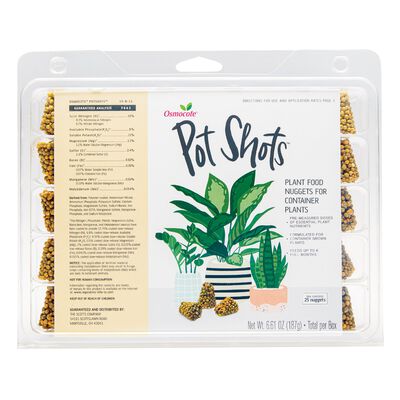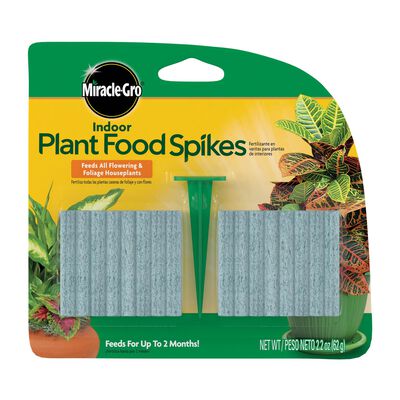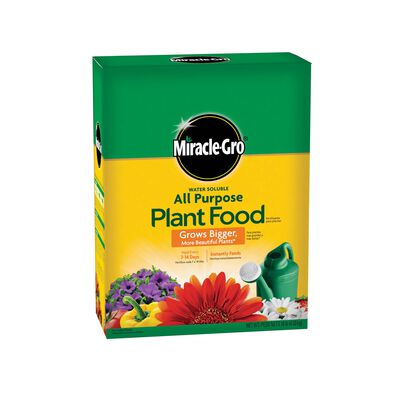
Plant Food for Houseplants
Satisfy a growing appetite by giving your plants a boost of nourishment.
Can plants have hunger pains? We've talked about the signs your plants will send when they need water, but how can you tell if your plant needs plant food? It'd be understandable if they got a bit cranky, but plants are more subtle about being hungry than we are. Usually, when a plant needs food, its growth begins to slow. It's easy for this to simply go unnoticed.
Rather than marking small notches on your doorframe to check on your plant's growth, you can ensure it's healthy with a regular feeding schedule. Plant food provides the right nutrients to maintain the steady growth and overall health of your plant. When you buy houseplants online at Greendigs, we also ship a starter supply of food with your plant so you're set up for success from day 1. In this article, we'll cover what plant food is, why it's beneficial for your plants, and how to apply it in a way that will help your plants thrive.
What Is Plant Food?
Vegan? Pescatarian? Keto? Exactly what diet does your plant need to be on? Just as with our diets, it's all about getting the right nutrients. And when it comes to plants, the key nutrients to look for in plant food are potassium (K), nitrogen (N), and phosphorus (P). This combination of nutrients delivers what your plant needs for healthy growth. Each of these ingredients will do something different for your plant's health.
- Potassium: Boosts your plant's defenses against disease and fluctuating weather conditions
- Nitrogen: Promotes growth
- Phosphorus: Stimulates growth from the roots to the tips of leaves, and offers a strong start for young or newly potted plants
Indoor plant food is formulated with a specific balance of these nutrients to help plants acclimate to and enjoy their environment.
What Are the Different Types of Plant Food?
How to plant food delivers nutrients to plants will differ upon the type of food. There are three main types of plant food: water-soluble, liquid, and slow release. All three types of plant food are available at our online plant store.
Slow release plant food, like Miracle-Gro Indoor Plant Food Spikes or PotShots™ Plant Food, will dissolve incrementally over time as you water. This means that after the application of a slow release plant food, you will conveniently be feeding your plant every time you water.
Water-soluble or liquid plant food, like Miracle-Gro Indoor Plant Food, can be delivered while watering. The main difference between them is that liquid plant food is pre-mixed, and water-soluble plant food must be dissolved in water.

Learning to Feed Your Houseplants
Being a plant parent can be confusing at first, but rest assured that feeding houseplants is a fun and easy task. You'll mainly need to keep two things in mind: the size of your plant's pot and the time between feedings. Whether you have a small low-maintenance houseplant or a large floor plant, feeding times and amounts will vary. Let's discuss how to feed houseplants to keep them looking and feeling their best.
1. Decide on a Preferred Plant Food
Are you more of a set-it-and-leave-it type or do you find feeding your plants to be a calming way to connect with nature? Select your plant food based on whether you like the hands-off method of slow release food, or the more frequent uses of liquid or water-soluble food.
2. Follow Instructions on the Label
The amount of food you use as well as how often is based on the product's instructions, so it's important to follow the label's guidelines. Your plant's pot size will dictate the amount of food needed, and the type of food will determine the frequency. For slow release foods this may be every 30 to 60 days, while liquid or water-soluble plant foods may require feedings every 7 to 10 days depending on the product.
If your plant has been potted in Miracle-Gro® Houseplant Potting Mix, wait 30 days before feeding with plant food. This potting mix already contains the nutrients houseplants need to get a strong start.
3. Keep a Schedule
Set alerts or mark your calendar to remember when your plant's next feeding is. Consistency is key to keeping your plant's health on track.


